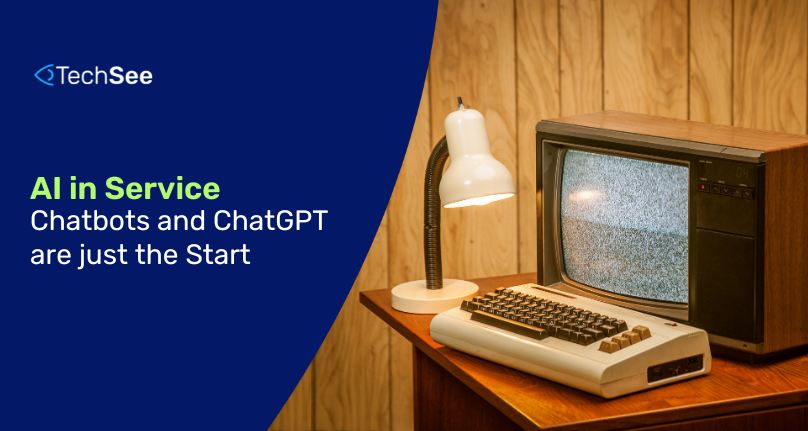Contents
AI is rapidly becoming a critical tool in customer service. While initial conversations now focus on improving chatbots with large language models (LLMs) like ChatGPT, this is just the start of what AI can and will offer. AI will streamline, augment and, in many cases, automate the customer experience and improve customer satisfaction. Getting there will require a broader perspective on service. Practical service automation requires a management layer that oversees and optimizes the LLM and integrates with the broader ecosystem of backend platforms and customer interfaces.
The Value of AI in Customer Service
One of the most significant advantages of AI-powered customer service is that it is available 24/7, allowing customers to receive assistance at any time of day or night. Similarly, AI easily scales up and down to meet changing demands, eliminating long wait times and poor CX during mass service events or seasons.
AI in customer service will likely start as a solution for quickly and efficiently handling routine inquiries, freeing human customer service representatives to focus on more complex issues. AI in Customer Service will reduce customer wait times and improve overall efficiency. Deploying this AI will require more than simply upgrading a chatbot.
The Value and Limitations of LLMs for Service
LLMs are great at reading, understanding, and writing text. But service requires far more than these core capabilities. Service requires making decisions and taking action across multiple platforms and environments.
Training an LLM to Know and Write
Standing up an LLM-powered chatbot requires training, tuning, testing, and validating the LLM’s knowledge and guidance. Once deployed, the LLM requires ongoing monitoring, optimizing, and retraining with new products or software version deployments. Like agents, the LLM must have visibility into system outage statuses and training on the latest agent guidance or best practices. Contact center agents often get daily or weekly briefings with the latest updates. You must equip your LLM to receive and utilize these updates like any agent.
While today this task can be performed manually, soon, this will fall to a Customer Service AI management layer that will constantly monitor and update the LLM.
Training an LLM to See and Guide
Today’s highest-performing service teams use visual tools to see what the customer sees and visually guide the customer to resolution. Visual communications consistently deliver faster and more efficient service, and higher. While GPT 4 offers the ability to see basic things, it cannot natively diagnose why a router isn’t working.
This level of service requires building a management layer on top of the LLM that can open a camera or otherwise receive an image and the customized computer vision models to meaningfully interpret the image as a human agent would. Similarly, sending the customer visual guidance requires that this LLM management tool sync with a visual AI that can apply augmented reality guidance overlays on top of the received images or live video and display this information to the user.
Training an LLM to the Tone of the Channel
By default, guidance from LLMs is often far longer than your average chat interaction. LLMs must be prompted and tuned to each service channel to make their instruction contextually appropriate. You wouldn’t start a chat conversation with a formal “Dear Jon” style address and wouldn’t end an email without a sign-off or signature. Adapt your LLM to suit each channel and audience.
Training an LLM to Hear and Speak
Many, if not most, customer inquiries come in via phone calls. Text-to-speech and speech-to-text technology continuously improve, and recent advances approach human-level clarity and intonation. Though LLMs require some tweaking to make them suitable for “voice” channels, this non-chat-based application shows incredible promise.
Building the Infrastructure for Customer Service AI
By design, AI-based customer service must be capable of performing the same actions and making the same decisions as human agents. This level of service automation requires that the AI management layer sync with an LLM to communicate with the customer and integrate with internal systems such as CRM, commerce platforms, and even ERPs to perform required validations and actions. These integrations will encompass primary API data syncs and AI-to-AI integrations between the service AI and the various AI solutions provided by each platform.
Proactive AI in Customer Service
In addition to the reactive service covered above, we must consider the role of proactive service. As AI technology advances, we can expect to see even more advanced applications, such as proactive customer service recommendations (e.g., We see your home wifi network is slowing down, would you like to optimize?), real-time service alerts (e.g., We have detected a network outage in your area, you may experience intermittent disruptions) and even predictive customer service that can anticipate customer needs before they even arise (e.g., It has been 11 months since you ordered replacement filters, would you like to purchase replacements today?).
Will AI Replace Humans Entirely? Not So Fast…
Of course, there are also concerns about the human cost of AI in customer service. These concerns are nothing new. Some worry that it could lead to job losses and a lack of personal touch or empathy in customer interactions. It’s important to remember that AI enhances the customer experience and will start by augmenting rather than replacing human agents. As technology advances and our society and customers grow more comfortable with AI, there will likely be some cases in which AI can better service customers than humans and others in which AI and humans will collaborate to help the customer best. By freeing up customer service representatives to focus on more complex issues, AI improves both the overall customer experience and the agent experience.
In conclusion, while upgrading a chatbot with an LLM like ChatGPT may seem like the future of customer service automation, this is only a tiny tactic in a much more significant strategic shift in service architecture and strategy. As AI technology advances, we can expect to see even more exciting applications in customer service.






